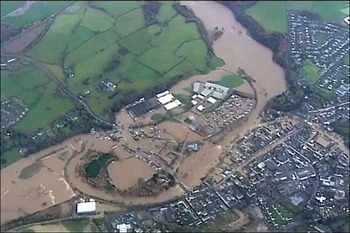 The floods in Cumbria are obviously attracting a lot of attention this morning. A couple of things are exercising my mind.
The floods in Cumbria are obviously attracting a lot of attention this morning. A couple of things are exercising my mind.
Firstly, as readers are pointing out, the claim that 340mm of rain fell in 24 hours seems suspect. Nobody seems quite sure where it came from. I have seen it suggested that this was the amount that fell over two days and in Unthreaded, Mike Post wonders if it is actually the November rainfall total.
Secondly, how do we know what the 100-year flood is in any given river basin? The process looks less than straightforward and involves a wealth of assumptions.
The first assumption is often but not always valid and should be tested on a case by case basis. The second assumption is often valid if the extreme events are observed under similar climate conditions. For example, if the extreme events on record all come from late summer thunder storms (as is the case in the southwest U.S.), or from snow pack melting (as is the case in north-central U.S.), then this assumption should be valid. If, however, there are some extreme events taken from thunder storms, others from snow pack melting, and others from hurricanes, then this assumption is most likely not valid. The third assumption is only a problem when trying to forecast a low, but maximum flow event (for example, an event smaller than a 2-year flood). Since this is not typically a goal in extreme analysis, or in civil engineering design, then the situation rarely presents itself. The final assumption about stationarity is difficult to test from data for a single site because of the large uncertainties in even the longest flood records[3] (see next section). More broadly, substantial evidence of climate change strongly suggests that the probability distribution is also changing[7] and that managing flood risks in the future will become even more difficult.[8] The simplest implication of this is that not all of the historical data are, or can be, considered valid as input into the extreme event analysis.
Lots to dig into.
 Bishop Hill
Bishop Hill